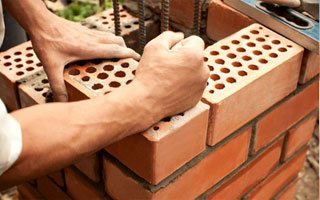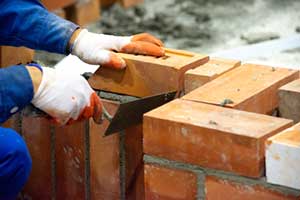Opening the Secrets of Sustainable Masonry Building And Construction Practices for Eco-Friendly Structures
In the world of contemporary building and construction, the quest of sustainable practices has actually ended up being paramount. Amongst the myriad methods to eco-friendly building, sustainable stonework building and construction stands out as a time-tested and long lasting method that holds a wide range of untapped capacity. From the option of materials to cutting-edge building strategies, the tricks to achieving sustainability within masonry building are multifaceted and appealing. By exploring the benefits, products, strategies, and future trends of lasting masonry, a much deeper understanding of exactly how these techniques can shape the future of environment-friendly buildings arises.
Advantages of Sustainable Masonry Construction
Embracing sustainable stonework construction practices not only decreases environmental effect however likewise supplies lasting economic benefits to contractors and areas. By using products like recycled bricks, obstructs, and rocks, contractors can dramatically decrease the carbon footprint of their jobs while advertising source effectiveness. In addition, lasting masonry building strategies, such as appropriate insulation and thermal mass properties, can improve power performance within structures, bring about reduced operational expenses over time.
Furthermore, the longevity and resilience of masonry structures add to lasting financial advantages. Structures constructed using sustainable masonry practices often require much less maintenance and fixing, equating to set you back financial savings for building contractors and home proprietors. The durability of masonry products likewise guarantees that frameworks continue to be steady and protected, decreasing the demand for regular renovations or replacements.
Eco-Friendly Masonry Materials
Making use of green masonry materials is an essential step in the direction of boosting the sustainability of construction techniques and decreasing ecological influence while making the most of lasting economic benefits. Lasting masonry products are sourced, generated, and utilized in a way that lowers overall environmental influence. Materials such as recycled blocks, reclaimed rock, and lasting concrete blocks are becoming progressively preferred choices for eco-conscious builders. Recycled bricks, for instance, not just divert waste from land fills however also require much less power to produce compared to new blocks. Recovered stone uses a special aesthetic charm while minimizing the demand for new quarrying. Sustainable concrete obstructs include recycled accumulations and might include improved insulation buildings, adding to energy performance in structures.
In addition, all-natural materials like adobe, rammed planet, and straw bundles give superb thermal mass properties, reducing the demand for home heating and cooling energy. These materials are commonly locally available, promoting local economies and reducing transportation-related carbon emissions. By selecting eco-friendly stonework products, building and construction projects can dramatically minimize their environmental footprint and add to the development of healthier, extra lasting developed environments.
Energy-Efficient Stonework Techniques
Power performance plays a vital function in improving the sustainability of stonework building practices. By implementing energy-efficient stonework methods, building contractors can substantially reduce the total power consumption of a building, causing reduced functional expenses and a smaller ecological impact. One essential energy-efficient stonework strategy is making use of thermal mass, which entails integrating thick products like concrete or block into the structure's framework to soak up and keep warm. This helps control indoor temperature levels, reducing the need for mechanical home heating and cooling systems.

Innovations in Lasting Masonry
Recent developments in lasting stonework practices have actually caused cutting-edge strategies that are improving the building and construction industry. One such innovation is the growth of self-healing concrete, which makes use of germs installed within the concrete to recover fractures autonomously. This advancement not just official statement reduces upkeep costs yet also enhances the toughness of stonework frameworks, adding to their sustainability.
One more noteworthy technology is using recycled accumulations in stonework building - masonry contractor. By including materials such as why not try these out crushed ceramic waste or recycled glass right into concrete mixes, building contractors can reduce the ecological influence of building and construction tasks while preserving architectural stability. This practice not only draws away waste from garbage dumps but also saves natural deposits, making it a vital development in sustainable stonework construction
In addition, the integration of digital layout devices, such as Structure Info Modeling (BIM), is transforming the means stonework frameworks are intended and built. BIM permits even more specific estimations, lowered product wastefulness, and improved energy performance, inevitably causing even more sustainable building techniques. These advancements collectively indicate an encouraging future for sustainable masonry building and construction in the era of eco-friendly structures.
Future Trends in Masonry Sustainability
With the innovative strides made in sustainable stonework methods, the future patterns in masonry sustainability are poised to more revolutionize the building industry. Among the vital fads shaping the future of stonework sustainability is the increased combination of innovation. Improvements such as Building Info Modeling (BIM) and virtual truth simulations are being used to enhance stonework building procedures, resulting in lowered product waste and enhanced power performance in structures.
Furthermore, the growth of novel lasting products is established to play a significant role in enhancing the eco-friendliness of stonework building and construction. masonry contractor. Technologies like self-healing concrete, recycled aggregates, and bio-based binders are gaining traction for their ability to minimize ecological impact while maintaining structural honesty

Final Thought
To conclude, sustainable stonework building and construction practices offer various benefits for green structures. By using eco-friendly products and energy-efficient techniques, masonry can add to an extra sustainable built environment. Technologies in sustainable stonework are continuously being developed to further improve the ecological performance of buildings. Looking in the direction of the future, the trend of stonework sustainability is expected to grow, resulting in more read what he said ecologically friendly and energy-efficient building practices in the years to find.